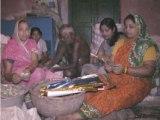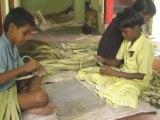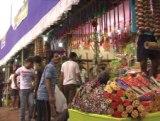Archives
ROCKET SCIENCE
“I learnt it in my in - laws’ house. After my marriage and for the last 20 years, I have been into the making of firecrackers,” says Rili Nayak of Trilochanpur while keeping herself engaged in making firecrackers.
| Because the business of making firecrackers is not yet recognised and the sector still remains unorganised, the young generation is not opting to make it a profession. |
To Hari Ghadai of Trilochanpur, it’s a good seasonal business of two months to be involved in. “Earlier, I was working outside. Now I am working in my home. The wages earlier was 50-60 rupees a day. Now it is 150 rupees a day,” says Hari.
That is why every member of the family including children contributes their mite in making more crackers, resulting in more benefit.
 “Since there is no agricultural work these days, we make firecrackers and make a good income so that we can live comfortably for the next 2-3 months. All our family members including women and children are involved in this work,” says Premalata Ghadai of Trilochanpur who is a village health worker and, also, makes firecrackers during her free time.
“Since there is no agricultural work these days, we make firecrackers and make a good income so that we can live comfortably for the next 2-3 months. All our family members including women and children are involved in this work,” says Premalata Ghadai of Trilochanpur who is a village health worker and, also, makes firecrackers during her free time.
Even though the village has witnessed a few shocking accidents it has never stopped making crackers. However, every ‘Deepavali’ comes with painful memories like those of the family of Aswina Behera.
 Aswina Behera, in her 60s now, still remembers the fateful Sunday in 2006 which took her husband, grandson, a relative and a cracker artisan forever in a fire accident caused by reasons that are till this day unknown. “I lost my husband, lost my 10 year old grandson, my daughter-in-law’s father and an artisan were killed in that accident. The house collapsed. Since then we stopped making firecrackers,” says Asvina Behera, her voice choked with emotion. Her family has stopped making crackers since then. But the village has not stopped from becoming the largest producer of crackers in the state.
Aswina Behera, in her 60s now, still remembers the fateful Sunday in 2006 which took her husband, grandson, a relative and a cracker artisan forever in a fire accident caused by reasons that are till this day unknown. “I lost my husband, lost my 10 year old grandson, my daughter-in-law’s father and an artisan were killed in that accident. The house collapsed. Since then we stopped making firecrackers,” says Asvina Behera, her voice choked with emotion. Her family has stopped making crackers since then. But the village has not stopped from becoming the largest producer of crackers in the state.
 It is largely unorganised labour that results in the manufacture of firecrackers in such a large volume. Though called the ‘Sivakasi’ of Orissa, this cottage industry is yet to get recognition despite the fact that almost every household in the village has been into the business for several years.
It is largely unorganised labour that results in the manufacture of firecrackers in such a large volume. Though called the ‘Sivakasi’ of Orissa, this cottage industry is yet to get recognition despite the fact that almost every household in the village has been into the business for several years.
“We have demanded recognition and support from the government which would benefit thousands who are involved in cracker manufacturing. But the government is yet to take any action in this regard,” says Yani of Padmapur.
 Because the business of making firecrackers is not yet recognised and the sector still remains unorganised, the young generation is not opting to make it a profession.
Because the business of making firecrackers is not yet recognised and the sector still remains unorganised, the young generation is not opting to make it a profession.
“One of my son studies his first year, the other is a BA, B.Ed. They are not interested in this. We can’t ask them to because we feel the hardship in this business. We don’t get a lucrative dividend even though we work hard. I somehow manage, but my sons can’t do the same,” says Fakir Charan Behera of Padmapur.
The life of the artisans and families engaged in cracker making also is under high risk for these two months even though nobody in the business is really bothered about the risks that come with the job.

